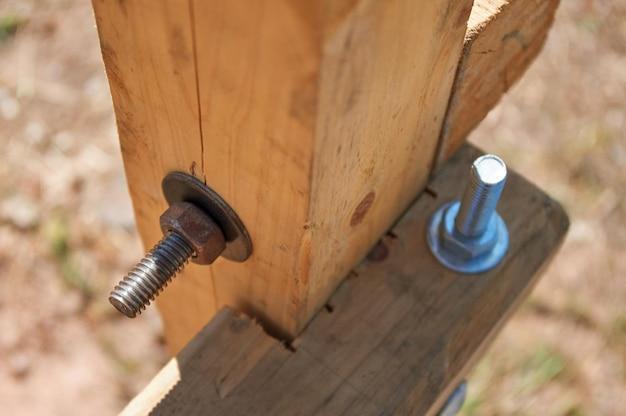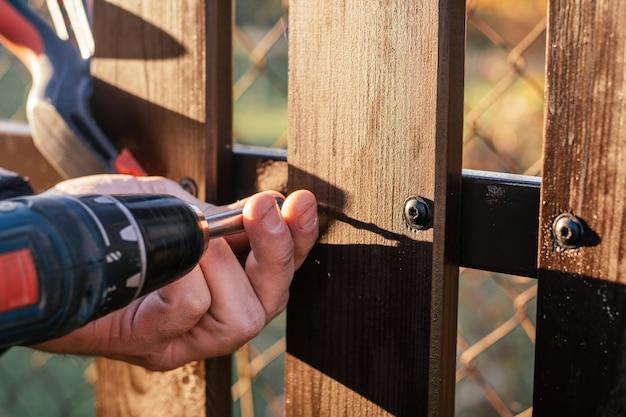When it comes to building or repairing a fence, one important aspect is ensuring that the fence rails are securely attached. One common question that often arises is, “What size screw should I use for fence rails?” The type and size of screws you choose can have a significant impact on the overall strength and durability of your fence.
In this blog post, we will explore the various factors to consider when selecting screws for your fence rails. We’ll discuss the benefits of using screws over nails, the recommended size of screws for different types of wood, and the importance of using the right fastening technique. Whether you’re a seasoned DIYer or a novice fence builder, this guide will provide you with the information you need to ensure a sturdy and long-lasting fence.
So, if you’re ready to dive into the world of fence construction, let’s explore the best size screws for fence rails and discover how to create a fence that will stand the test of time.
What Size Screw Should You Use for Fence Rails
Choosing the Right Screw for Your Fence Rails: A Guide Worth Screwing Around With!
When it comes to building a sturdy fence, the type and size of screws you use may seem like small details. But let me tell you, my friend, these tiny fasteners play a crucial role in ensuring the longevity and durability of your fence. So, let’s dive right into the world of screws and find out what size is perfect for those fence rails!
The Screw Size Conundrum: Should You Go Big or Go Home
When it comes to screw sizes, it’s essential to strike the right balance. You don’t want a screw so small that it won’t provide enough support, nor do you want one so big that it causes the wood to split. So, what’s the magic number, you ask? Well, it depends on a few factors.
The Wood Type: Softwood or Hardwood, What’s Your Flavor
Before we get into the nitty-gritty of screw sizes, let’s talk about wood types. Softwood, like spruce or pine, is more forgiving when it comes to screws. Hardwood, on the other hand, is tougher and often requires slightly larger screws.
Screw Sizing 101: Good Things Come in Small Packages
For most fence rail installations, a #8 or #10 wood screw will do the trick. These sizes offer a solid balance between strength and ease of installation. Plus, they won’t break the bank.
The Length Matters: Long Screws for Deep Satisfaction, or Short Screws for Quick Satisfaction
When it comes to screw length, we’re not talking about personal satisfaction here. For fence rails, you’ll want screws with a length of at least 2.5 inches. If you’re attaching thicker rails or using screws to secure them to posts, opt for longer screws, around 3 inches. The longer the screw, the stronger the connection, and the less likely it is to pull out.
A Word of Caution: Don’t Over-Tighten, You Trigger-Happy DIY Enthusiast!
As tempting as it might be to wield your power drill like a superhero, remember this: over-tightening screws can lead to disaster. It can cause the wood to split or weaken its structural integrity. So, put on the brakes, my eager DIY friend, and tighten those screws just enough to secure the fence rails without going overboard.
Conclusion: It’s Screw-ingly Simple!
When it comes to fence rails, choosing the right screw size is crucial for a sturdy and long-lasting structure. Remember to consider the type of wood you’re working with, opting for a #8 or #10 wood screw, and selecting a length that suits your needs. And above all, don’t let your enthusiasm get the best of you—use just the right amount of force. Because when it comes to fence building, precision wins the race!
FAQ: What Size Screw For Fence Rails
Welcome to our comprehensive FAQ guide on choosing the right size screw for fence rails. Attaching fence rails securely is vital for the stability and longevity of your fence. We understand that selecting the correct screws can be confusing, so we’ve compiled a list of frequently asked questions to help you navigate this process with ease. So, let’s jump right in and answer all your burning questions about the ideal size screws for fence rails!
How do you attach a fence rail to a post
To attach a fence rail to a post, follow these simple steps:
- Position your rail: Hold the fence rail horizontally against the posts at your desired height.
- Pre-drill holes: Pre-drill holes through the rail and into the post using a drill bit slightly smaller than your screws. This will prevent the wood from splitting.
- Screw it in: Align the pre-drilled holes and drive the screws into the post until they’re flush with the surface of the rail. Make sure to use corrosion-resistant screws for outdoor applications.
What size screws should I use for a fence
The ideal size screws for a fence depend on the thickness of the fence rail and the materials used. For most standard wooden fences, 2 ½ to 3-inch long screws are typically suitable. However, it’s important to consider the quality and condition of your wood, as well as the specific design of your fence.
What size screws should I use for 2×4 fence rails
For attaching 2×4 fence rails, 2 ½ to 3-inch screws are generally recommended. These screws provide enough length to securely fasten the rails to the posts, ensuring the stability of your fence.
Should you use screws or nails for a fence
Screws are generally the preferred choice over nails for fence construction. Unlike nails, screws provide superior holding power and are less likely to pop out or loosen over time. Additionally, screws are easier to remove if you need to make any adjustments or repairs to your fence in the future.
How do you fasten fence rails
Fastening fence rails is a straightforward process. Here’s what you need to do:
- Determine the rail’s position: Position the rail horizontally against the posts at your desired height.
- Pre-drill holes: Pre-drill holes through the rail and into the post using a drill bit slightly smaller than your screws.
- Secure with screws: Align the pre-drilled holes and drive screws into the post, ensuring they penetrate the rail. Continue this process for all rails.
Are nails or screws better
Screws are generally better than nails for fence construction. While nails are cheaper and easier to install, they provide less holding power and are more prone to loosening or pulling out. Screws, on the other hand, offer superior grip and durability, resulting in a sturdier fence that will withstand the test of time.
What kind of screws do you use for pressure-treated wood
When working with pressure-treated wood, it’s crucial to choose screws specifically designed for this type of lumber. Stainless steel or hot-dipped galvanized screws are the best options since they are resistant to corrosion and won’t react with the chemicals used in pressure-treated wood.
What nails should I use for feather edge fencing
If you prefer to use nails for feather edge fencing, opt for galvanized or stainless steel nails. These nails are resistant to rust and corrosion, ensuring they maintain their strength and integrity over time.
Should fence rails be level or follow the ground
Fence rails should typically follow the natural slope of the ground. It’s essential to ensure that the tops of the fence rails remain level even if the ground underneath is uneven. This ensures a neat and visually appealing fence, while also providing the necessary structural support.
What is a good nail gun for fencing
If you prefer using a nail gun for fencing, a pneumatic nail gun designed for framing applications is an excellent choice. Look for a nail gun that can accommodate the size and type of nails recommended for your specific fencing project.
Can you use 2×3 for a fence
While you technically can use 2×3 lumber for a fence, it is not recommended for structural purposes. 2×4 lumber provides better strength and stability, ensuring that your fence remains sturdy and secure.
What is the best wood to use for fencing
Cedar and redwood are two of the best wood options for fencing. They are naturally resistant to decay, rot, and insect damage, making them highly durable choices for outdoor applications. Additionally, their distinct grains and warm tones add an aesthetic appeal to any fence.
What size wood should I use for fence rails
For most standard fences, 2×4 lumber is the most common choice for fence rails. This size provides sufficient strength and stability to support the weight of the fence panels and withstand the elements.
What screws should I use for fencing
When it comes to screw selection for fencing, opt for outdoor-rated deck screws or exterior wood screws. Ensure that the screws are corrosion-resistant, as they will be exposed to various weather conditions. Use the appropriate length of screws based on the thickness of your fence rails and the materials used.
Can I use a finish nailer for fencing
While a finish nailer can technically be used for fencing, it is not the most suitable tool. Finish nailers are designed for small, delicate finish work and may not provide enough holding power for a fence. It is best to use screws or a framing nailer designed for larger, structural projects.
What size screws should I use
The ideal size of screws depends on the specific application. As a general guideline, 2 ½ to 3-inch screws are commonly used for most fencing projects. However, always consider the thickness of the materials being joined and choose screws that provide sufficient penetration and holding power.
How do you attach a 2×4 to a 4×4
To securely attach a 2×4 to a 4×4, follow these steps:
- Position the boards: Hold the 2×4 horizontally against the side of the 4×4.
- Pre-drill holes: Pre-drill pilot holes through the 2×4 and into the 4×4 using a drill bit slightly smaller than your screws.
- Drive screws into place: Align the pre-drilled holes and drive screws into the 4×4 until they are flush with the surface of the 2×4. Ensure that the screws penetrate both boards for a strong connection.
We hope this FAQ guide has shed light on the appropriate size screws for fence rails and provided valuable insights into the process of securing your fence. Remember to choose screws that are suitable for the type of wood you’re using, and always prioritize durability and longevity when making your selection. By using the right screws, you can ensure that your fence stands strong and adds charm to your outdoor space for years to come.
Are there any other questions you have about screw sizes for fence rails? Let us know in the comments below, and we’ll be happy to assist you!
Note: This blog post is for informational purposes only and should not be considered as professional advice. Always consult with a qualified professional for specific recommendations regarding your fencing project.

